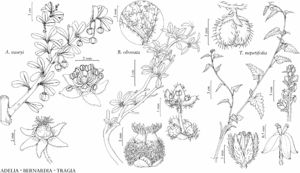Adelia
Syst. Nat. ed. 10, 2: 1285, 1298. 1759.
| Taxon | Illustrator ⠉ | |
|---|---|---|
 | Tragia nepetifolia Bernardia obovata Adelia vaseyi | Barbara Alongi Barbara Alongi Yevonn Wilson-Ramsey |
Shrubs [trees], unarmed or branchlets sometimes stiff and thorn-tipped, dioecious [monoecious], hairs unbranched; latex absent. Leaves deciduous, fascicled on short-shoots [alternate], simple; stipules present, deciduous; petiole present, glands absent; blade unlobed, margins entire [crenate], laminar glands absent; venation palmate at base and pinnate distally [pinnate]. Inflorescences unisexual [bisexual], axillary, fascicles [racemes] or flowers solitary; bracts subtending pistillate flowers minute, not enlarging in fruit; glands subtending each bract 0. Pedicels present. Staminate flowers: sepals [4–] 5, not petaloid, 2 [–5] mm, valvate, distinct; petals 0; nectary extrastaminal, annular [5 glands], adnate to calyx; stamens [6–-] 14–17 [–30], connate basally [distinct]; pistillode present [absent]. Pistillate flowers: sepals 5 (–6) [–7], distinct; petals 0; nectary annular; pistil (2–) 3 (–4) –carpellate; styles (2–) 3 (–4), distinct [connate basally], deeply multifid. Fruits capsules. Seeds subglobose; caruncle absent.
Distribution
Tex., Mexico, West Indies, Central America, South America, tropical and subtropical regions
Discussion
Species 9 (1 in the flora).
Phylogenetic analyses of morphological and molecular data support Adelia as a monophyletic group sister to the Caribbean genera Lasiocroton Grisebach and Leucocroton Grisebach (De-Nova and V. Sosa 2007). Three principal lineages were recognized in Adelia: the first includes only A. cinerea (Wiggins & Rollins) A. Cervantes, V. W. Steinmann & Flores Olvera, a species endemic to Mexico; the second includes four Mexican species (including A. vaseyi); and the third comprises the remaining four species from the West Indies, Central America, and South America.
Selected References
Lower Taxa
"connate" is not a number. "distinct" is not a number.